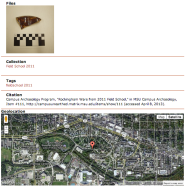Day of DH!

The Day of DH is a national celebration of the range and variety of people, projects, and groups involved in digital humanities (DH). This year the event is hosted by MSU’s own DH center: MATRIX: The Center for the Digital Humanities & Social Sciences. It is a community sourced online publication and project to bring together scholars interested in DH. This year, Day of DH is taking place today, April 8th. Participants answer questions about what digital humanists do, how they work together, and provides them a chance to document their activity on this one day.
You can follow along today by visiting dayofdh2013.matrix.msu.edu or through Twitter with the hashtag #dayofdh.
Campus Archaeology is going to be participating through the blog, facebook, and twitter, so make sure to follow us on our day of DH! We use a number of digital resources to aid in our research and surveys, but also to communicate with the broader public.
Today, in celebration of the Day of DH, we are going to be working on two projects that will aid with preserving the archaeological heritage of MSU. Our intern Josh is working on adding all our archaeological surveys and excavations to a geographic information system, and I will be working on updating our OMEKA museum website. Stay tuned for updates and photos on Twitter and Facebook throughout the day!
Update from our #DayofDH
8:00am EST: Good morning!
8:15am EST: Working with Katie to get one of the undergrad posters done for the upcoming UURAF, a symposium for undergrads to show off their research. Their poster is on classifying the Saints’ Rest material we excavated in the Fall. It is interesting to see all the artifacts and what they’ve learned from them. When we make posters, we actually use powerpoint to design them, and then save them as large PDFs. It is an easy way to make posters because it is drag and drop, and can be set to the specific large size of the poster.
8:56am EST: Finished with draft #1 of the poster.
9:45am EST: Last year, we designed an OMEKA museum site for Campus Archaeology. We haven’t fully used this program- partially because there is so much to do and partially because I still have problems sometimes making it work properly.

Today my goal is to finally add spatial data to the artifacts. This means assigning a geolocator (longitude and latitude) to every artifact we have online. Shouldn’t be too hard since many are located in the same area! Check out the progress here at campusunearthed.matrix.msu.edu/.
11:00am EST: I was able to update a dozen or so of the items on the OMEKA with their geolocation, and it seems to be working pretty well! In addition to this, Katie has been able to get the next draft of her poster done and added in some sweet photos of the Saints Rest collection from the 2012 excavation. However, if you want to see that work you’ll have to head over to the undergrad symposium this friday at the MAC Union!
Thinking about DH and CAP: Here at Campus Archaeology, digital tools are integrated into every stage of our workflow- it is inescapable, but in a good way. At every stage of the work we do there is a strong digital and analog component. Any dig we begin starts with research online and in the archives. We investigate GIS maps, both our own and the one created by the university’s Physical Plant so that we can prepare an excavation or survey plan. As we learn more about the work we are going to be doing, we share this information through social media and our blog. Once we are out in the field, we tweet and photograph everything that we are doing. When the dig in complete, we catalog every artifacts into a database, add the new excavation data to our GIS, and write up everything for our blog. It is incredible that even as a discipline so concerned with the past, our methods and techniques are constantly being updated with new technology. But what does this have to do with the digital humanities? If you followed along with others on their Day of DH, you know that it is an inclusive and highly varied field that is loosely based on the intersection between digital technology and humanities related disciplines. DH is exciting, not because it is finding new ways to display data or share information, but because it is based on values of innovation, engagement, and community interaction. We at Campus Archaeology are committed to these- we are always searching for ways to improve our research and better share our findings through new digital tools like OMEKA, we strive to engage with people on a number of both digital and analog levels through social media and engagement events, and we are dedicated to interacting with the MSU, East Lansing, and broader community interested in learning about and preserving history.
Author: Katy Meyers Emery

